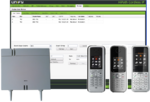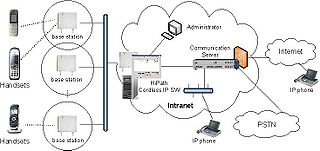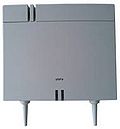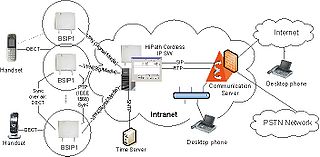Difference between revisions of "HiPath Cordless IP"
The Wiki of Unify contains information on clients and devices, communications systems and unified communications. - Unify GmbH & Co. KG is a Trademark Licensee of Siemens AG.
| Line 225: | Line 225: | ||
'''System Configuration'''<br /> | '''System Configuration'''<br /> | ||
| + | |||
'''If the HiPath Cordless IP Server SW has been activated on one of the DECT IP base station, the following system restrictions apply (small solution):'''<br /> | '''If the HiPath Cordless IP Server SW has been activated on one of the DECT IP base station, the following system restrictions apply (small solution):'''<br /> | ||
* up to 10 DECT IP base stations | * up to 10 DECT IP base stations | ||
| Line 253: | Line 254: | ||
<br /> | <br /> | ||
| + | |||
| + | '''''In case of replacement of an existing DECT or DECT IP solution (i.e. when base stations from other vendors or Unify BS4 are replaced by BSIP1), a new site survey is mandatory. Each base station type behaves differently regarding HF characteristics, so a simple replacement may cause coverage problems. ''''' | ||
| + | |||
If you'd like to find out more visit http://www.unify.com or ask your Siemens Channel Partner for a demonstration today. | If you'd like to find out more visit http://www.unify.com or ask your Siemens Channel Partner for a demonstration today. | ||
Revision as of 09:42, 23 October 2014
HiPath Cordless IP V1 is the DECT over IP solution for Unify IP platforms.
The radio technology used in the HiPath Cordless IP solution complies with the DECT (Digital Enhanced Cordless Telecommunications) standard. The HiPath Cordless IP solution makes the DECT standard already established for mobile voice communications also available in Voice over IP infrastructures.
The flexibility in number of users, user density, coverage, extensibility and the provision of comfort features with the up-to-date DECT Handsets characterize the system architecture of HiPath Cordless IP. The connection to the Voice over IP infrastructure of the Communication Server is made by means of the SIP protocol. This means that DECT radio cells are the perfect way to supplement SIP-capable Voice over IP systems as mobile communication solutions.
Contents
- 1 Key Features
- 2 Solution Components
- 3 Overview
- 4 Connectable Devices
- 5 Diagnostics Requirements
- 6 Technical Data
- 7 Documentation and Training
- 8 See also
Key Features
The entire radio range managed by the system consists of DECT IP base stations that either together form a seamless network of overlapping and synchronous radio cells or individual islands of radio signals. The size of a radio cell depends on local conditions.
DECT IP base stations support the seamless handover of existing voice connections, in other words the changeover between the radio cell and a DECT handset during a call. In addition, the roaming function is made available to mobile users, i.e. the change of radio system without an existing call.
Solution Components
The HiPath Cordless IP system solution consists of the following main components:
- Handsets: DECT handset with PN-CAP functionality
- Base station: HiPath DECT IP base station with PN-CAP/ GAP functionality for the supported DECT handsets and IP interface with the Ethernet network
- HiPath Cordless IP software is the central software component for:
- controlling the DECT IP base stations
- implementing the SIP/RTP interfaces in the direction of the Communication Server
- central administration and configuration of the entire HiPath Cordless IP solution
- in the large solution the HiPath Cordless IP SW is split into a management server and multiple media servers
The HiPath Cordless IP software can be activated either on one of the DECT IP base stations. Nevertheless, this DECT IP base station allows making calls. Or the HiPath Cordless IP SW can be shifted to a dedicated standard Server or is distributed over multiple servers to realize larger configurations. The server as well as the Server OS (openWRT) is part of the solution approach of HiPath Cordless IP.
Overview
This section gives you an overview over the most important features of HiPath Cordless IP V1.
DECT IP base station (BSIP1)
DECT IP base stations form a network of radio cells and conduct communications with the DECT handsets. Special antennae can be used for increased radio ranges. The DECT IP base stations can be fitted with an outdoor casing to protect against inclement weather. DECT IP base stations have the complete software for DECT and IP functionality. This software does not need to be configured and administered locally on the DECT IP base stations; this can be conveniently implemented on a centralized basis by means of the HiPath Cordless IP software.
HiPath Cordless IP Server SW
The HiPath Cordless IP software has several functions, only exists once in the system and can be activated on one of the DECT IP base stations or on dedicated servers.
Function: Router and protocol converter
HiPath Cordless IP software is the interface between the IP DECT base stations on the one hand and the Communication Server on the other. It has a router and protocol converter function whereby it controls the voice connections between the Communication Server and the relevant DECT IP base station and also converts these into a data format that can be used by the DECT base stations. Only the HiPath Cordless IP software knows the DECT IP base stations with which the relevant handsets are associated; this is not apparent to the Communication Server. The HiPath Cordless IP software is a Gateway User agent for the Communication Server which manages the configured handsets. The HiPath Cordless IP software is also used to register all handsets on the Communication Server; this software administers the login procedure and the active DECT handsets. In the large solution the management server and multiple media servers provide the HiPath Cordless IP SW functionality. The management server is responsible for administration and subscriber database, the media server convert the protocols between the communication server and the DECT base stations.
Function: Configuration and administration interface
All administration and configuration of DECT IP base stations and of the HiPath Cordless IP software itself is executed by means of the web-based management of HiPath Cordless IP software.
Function: Synchronization management
In DECT systems with a circuit-switched connection, e.g. HiPath Cordless Office systems, the synchronization information required to synchronize the base stations is derived from the UP0 connection. This is because of the IP connection of the base station not possible in the case of the HiPath Cordless IP system. However, accurate time synchronization between the DECT IP base stations is vital for a seamless call handover. A seamless handover cluster is formed between synchronous DECT IP base stations; calls can only be handed over seamlessly in this cluster. More clusters of this type are possible for each Communication Server, however these are not synchronized with each other. Seamless handover is not possible between different non-synchronous clusters.
Synchronization via DECT to form a seamless handover cluster (synchronization via air)
In order to synchronize with another DECT IP base station via the DECT interface, a DECT IP base station must be within the overlap area of the radio cell that forms this DECT IP base station.
In addition, the DECT IP base station can be synchronized on other DECT IP base stations, which increases the availability of synchronicity in this cluster.
In the event that synchronicity is lost, this DECT IP base station no longer accepts calls. After all ongoing calls on the asynchronous DECT IP base station have been ended, an attempt is made to resynchronize this DECT IP base station. Only then can new calls be made on this DECT IP base station.
Synchronization via LAN
Compared to Air Based Synchronization mechanisms, synchronization via Ethernet (acc. IEEE1588, PTP Precision Time Protocol) requires less configuration.
On the other hand, strict Ethernet requirements should be satisfied: like symmetry, packet loss, delay and jitter (variance of delay). Therefore special attention should be taken in evaluating Ethernet requirements of active components (especially the Ethernet Switches). Exceeding of limits (especially of jitter) will lead to loss of synchronization, which will finally lead to a resynchronization process. During this process the belonging base stations are unable to establish telephone calls. The IEEE 1588 Synchronization uses a star shaped topology only. Maximally one base station works as Synchronization Master, all other base station which participates at the synchronization process works as Synchronization Slaves.
The main advantages of synchronization via LAN are:
- more flexibility in the location of the DECT IP base station - no need to built synchronisation chains as required by synchronisation via DECT,
- less DECT IP base stations are required, because the overlapped area of DECT IP base station is less,
- configuration of DECT IP systems is simplified, because all DECT IP base stations can be synchronised to only one synchronisation master.
When you want to use syncronization via LAN, a Project Specific Release (PSR) is needed. Please contact product management
You can find more information here.
Communication Interfaces
The following is an overview of the communication relationships used in the solution:
DECT handset - user: DECT handset, with alternative Headset oder Bluetooth headset
DECT handset – DECT IP base station (BSIP1): A call can be handed over seamlessly between the DECT IP base stations.
DECT IP base station (BSIP1) – DECT IP base station (BSIP1): Accurate time synchronization between the DECT IP base stations is vital for a seamless call handover.
DECT IP base station (BSIP1) – HiPath Cordless IP software: The DECT IP base stations all communicate with the HiPath Cordless IP software; the voice and signaling data is transported in this connection. The connection protocol between the DECT IP base stations and the HiPath Cordless IP software is system specific; it is IP-based and uses UDP packages in both directions.
HiPath Cordless IP software – Communication Server: The SIP protocol between the HiPath Cordless IP software and the Communication Server is standards-based.
HiPath Cordless IP software - time server: A time server is not absolutely necessary. The time information is used to display this when the DECT handset is idle and to file the caller list with correct data. The Communication Server can also be managed as a time server.
HiPath Cordless IP management server – Media server: In the large solution the HiPath Cordless IP SW functionality is split between management server and multiple media servers .
Features that can be made available on the Supported Devices
In addition to the local features of the handsets such as redial list or integrated phonebook, the HiPath Cordless IP solution provides the following system features on the supported DECT telephones:
- outgoing/incoming calls
- calling line identity presentation (CLIP)
- hold – including music on hold while a caller is waiting
- consult
- toggle
- attended/unattended transfer
- 3-party conference
- Distinctive Ringing
- Message Waiting Indications for Voice Mails
- Group Calls (e.g. MULAP)
- Call forwardings station controlled
- Attended / unattended transfer
- 2nd line / Call Waiting
- 3rd party call control (for OpenScape Voice, OpenScape Office and OpenScape Busniness)
- Call Pickup Group (for OpenScape Voice only)
- Call completion (for OpenScape Voice only)
- ringer tone mute by incoming calls
- call reject
- time and date display at idle screen
- internal/external call ringer differentiation
- missed call list for incoming calls on a free DECT handset, including MWI signaling
- received call list
- DTMF transmission
- Integration of DECT handsets into MULAP groups
- group call possible between DECT handset and optiPoint / openStage (both phones ring when an incoming call is received; when the call is answered using one of the two phones, the other phone stops ringing)
Telephonebook options:
- corporate directory: LDAP Access via DECT handset
- group directory: Cordless internal directory (max. 400 entries)
- private directory: handset internal directory
Features per supported Platform:
You can find here a detailed overview of the features with the different platforms.
Connectable Devices
Supported Platforms
HiPath Cordless IP SW is activated on one of the base stations (small solution):
- OpenScape Office MX / LX, from V3
- OpenScape Business, from V1
- OpenScape 4000, from V7
- OpenScape Voice, from V8
HiPath Cordless IP SW runs on a server (server solution):
- OpenScape Office MX / LX, from V3
- OpenScape Business, from V1
- OpenScape 4000, from V7
- OpenScape Voice, from V8
HiPath Cordless IP SW is distributed over multiple servers (large solution):
When you want to offer the large solution to your customer, a project specific release (PSR) is required. Please contact product management
Supported DECT handsets
- Gigaset SL3 professional
- OpenStage SL4 professional
- Gigaset S3 professional
- Gigaset S4 professional
- Gigaset M2 professional
- OpenStage M3
Diagnostics Requirements
The following info is required for call and handset related problems:
- The detailed, actual problem description including the following info
- The statistical distribution of the problem
- The current site plan (position plan) of the base stations
- A current network deployment plan including the following info as picture
- The radio coverage at the location where the problem occurs
- A Wireshark trace recorded at a mirror port of the IWU of the BSIP
- Attach also the internal diagnosis data from the PBX
- PSR files if PSR required
For WBM related problems and for more details please read the document "HiPath Cordless IP Diagnostics requirements", which you can find in the documentation area below.
Technical Data
Features of the DECT IP Base Station (BSIP1)
Features - DECT
- Support for the maximum number of DECT channels
- Extended scope of features for the supported DECT handsets (PN-CAP standard)
- Support for antenna diversity
Features - Ethernet
- Ethernet 10/100 Base T connection
- Power-over-Ethernet Power Class 2 (IEE802.3af)
- Software download/update available
- Echo cancellation
- Integrated http/https server for accessing the solution's Web-based management
Additional features if the HiPath Cordless IP Server Software has been activated on the DECT IP base station - on the Communication Server route, this DECT IP base station also offers:
- VLAN
- SNMP V2
- DHCP options - DCHP on or local entry of IP addresses
- SIP via TCP and UDP
- Quality of Services in the network:
- Layer 2 prioritization (802.1p/q)
- Layer 3 prioritization (ToS, DiffServ)
SIP Survivability Features
- Support of Outbound Proxy
- DNS Administration
- Support of DNS SRV
- Penalty Box Functionality
- SIP Notify Messages
Miscellaneous
- outdoor casing for BSIP1 available
- mast mounting kit for outdoor casing can be ordered from Unify
- special antennas from Huber&Suhner can be used (http://www.hubersuhner.com/de-DE/)
- a metallic casing for BSIP1 (to reduce HF emission) is provided by Böhm Elektronik (http://www.boehm-elektronik.com/)
Network Requirements
If Voice over IP is to be integrated in a network environment, it is necessary to create conditions so that the voice connections can be operated smoothly by means of IP networks. The IP network must meet the general requirements for a VoIP network in relation to delays, losses and guaranteed service quality features.
In addition, the following special conditions must be met between the DECT IP base stations and the HiPath Cordless IP server software (the media servers in the large solution) in the IP network:
- these must be part of the same Ethernet segment; neither layer 3 routing via an IP router or Network Address Translation (NAT) are supported
- in the large solution a layer 3 connection between media servers and between a media server and the management server is allowed.
- at least 2 priority classes according to IEEE 802.1 p/q are required in the VoIP network in order to prioritize the voice data
- Use of 100 Mbps full duplex for all switched LAN ports
Otherwise delays occur in the IP network, leading to synchronization and voice quality problems on the DECT handsets.
Additional requirements if using LAN synchronization:
- the maximum number of three cascaded Ethernet switches are supported between the Synchronisation Master and every Synchronisation Slave
- only premium class switches, which fulfill the requirements regarding Ethernet synchronization according IEEE1588, are supported.
You can find more information here.
Please read the configuration hints and restrictions in the HiPath Corldess IP release note carefully and act accordingly.
System Configuration
If the HiPath Cordless IP Server SW has been activated on one of the DECT IP base station, the following system restrictions apply (small solution):
- up to 10 DECT IP base stations
- up to 10 parallel calls
- up to 50 DECT handsets could be activated
If the HiPath Cordless IP Server SW runs on a Server, the following system restrictions apply (server solution):
- up to 60 DECT IP base stations
- up to 50 parallel calls
- up to 300 DECT handsets could be activated
If the HiPath Cordless IP Server SW runs on a management server and multiple media servers (large solution):
- up to 120 base stations per media server
- up to 5 media servers in a handover domain/site
- up to 100 media servers per system
- up to 3.000 parallel calls per system
- up to 20.000 DECT handsets per system
- the media server can be configured to provide up to 30/60/90/120 parallel calls
You can find more information to the required Server here.
Analysis of the Building/Campus (Site Survey)
When the DECT network involves approximately 3 DECT IP base stations, a site survey is recommended. This is particularly the case if:
- several floors or buildings are to be covered with DECT
- the solution will have to coexist with other DECT installations
- other radio-intensive devices are operated in the environment.
In case of replacement of an existing DECT or DECT IP solution (i.e. when base stations from other vendors or Unify BS4 are replaced by BSIP1), a new site survey is mandatory. Each base station type behaves differently regarding HF characteristics, so a simple replacement may cause coverage problems.
If you'd like to find out more visit http://www.unify.com or ask your Siemens Channel Partner for a demonstration today.
Documentation and Training
|
Information
Documentation
-
 HiPath Cordless IP V1 Service Manual
HiPath Cordless IP V1 Service Manual -
 HiPath Cordless IP V1, Administrator Documentation
HiPath Cordless IP V1, Administrator Documentation -
 HiPath Cordless IP V1 Einrichtung SIRA-Zugang
HiPath Cordless IP V1 Einrichtung SIRA-Zugang -
 HiPath Cordless IP V1 user guide with Gigaset S4 prof
HiPath Cordless IP V1 user guide with Gigaset S4 prof -
 HiPath Cordless IP V1 user guide with OpenStage SL4 prof
HiPath Cordless IP V1 user guide with OpenStage SL4 prof -
 HiPath Cordless IP V1 user guide with OpenStage M3
HiPath Cordless IP V1 user guide with OpenStage M3 -
 CE certificate
CE certificate -
 Diagnostics Requirements
Diagnostics Requirements
Training
- Basics course of HiPath Cordless IP for Consulting/ Sales - SVU on Demand (HCIBASUDV)
- Basic course installation/ service of HiPath Cordless IP - SVU on Demand (HCIV1R4UDS)
- Deployment HiPath Cordless IP V1 R5 – Delta Training - SUV on Demand (HCIV1R5UDS)
Remark: There is a MyTraining Login of the Academy for Professional Training required.
See also
Platforms:
Handsets:









